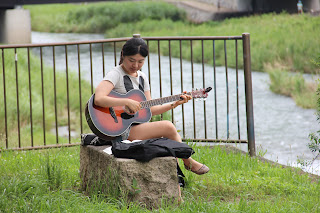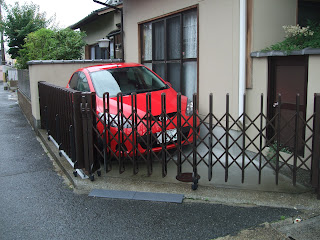* de Nederlandse tekst vind je verderop *
When I - without
any hesitation - closed my eyes for a power nap in a cafe in downtown Tokyo, I realised
that I have gotten well accustomed into Japan. I would never do this in any other city outside Japan. Nor would I go downstairs to buy another coffee, leaving all my
valuables unattended. According
to our standards sleeping is something intimate that belongs to the private
domain. But here in Japan sleeping in public is common practice. Most offices
facilitate by placing coaches and even the university library has rows of soft
comfortable fauteuils, so tempting for a nap especially on hot days. Many do, which I perfectly understand, but I
can’t help feeling a bit uncomfortable when reading in an academic book with a
slightly snoring student next to me.
On the other hand, the Japanese consider talking,
with each other or by telephone as something strictly private. So when in
public you speak very softly, avoid making telephone calls and switch off the
sound. As a result you experience a kind of silence when in public, which is
nice, in particular when in the library. Remarkably though this pleasant stillness is regularly roughly disturbed by an extremely loud sneeze. With the same forceful dedication the Japanese
– at least Japanese men – have the habit to scrape the throat, not once but on and on and on. Fortunately the final climax – that disgusting habit
which is still common practice in China – is inappropriate in Japan, but apparently
the long, noisy prelude is acceptable when in public.
Now summer has really started, I observe
another remarkable difference in the perception of public and private. Balconies and roof terraces remain empty. Used to Mediterranean habits, we put the table
outside, have dinner and enjoy the cool breeze that softly blows from the
mountains. Nobody does, even not in our apartment building where many foreigners
live. Windows, sliding doors, and curtains remain closed. Nobody to be seen.
Nothing to be heard. Apparently the balcony belongs to the public space, so it
will not be used for private affairs. It is
just used for storage and as a work space. Our washing machine for example is
placed right in the middle, handy for washing indeed, but besides it is a real
stand in way.
During these hot summer weeks the Japanese
literally pay a high price for their habit to hide inside their homes. Instead
of using cool breezes to lower temperatures, the airco’s – energy guzzler
number one – are working overtime, albeit to eliminate the heat of the refrigerator
motor in the small kitchen. Applying natural ways to keep summer
life bearable, would save a lot of energy and money. People could easily save
10 per cent on electricity by adjusting the airco to 1 degree higher. From next
week on however we will all be forced to seek alternatives for cooling down. The
electricity company just send us the schedule of planned power outages in
August. We are kindly requested to take
measures during days with a high chance of blackout. Isn’t this the ideal
moment to break with traditions and to turn balcony and roof terraces into
refreshing, green, comfortable indoor-outdoor spaces?
Tijd voor een frisse wind
Toen ik in een café in Tokyo zonder aarzelen mijn
ogen dicht deed voor een dutje, besefte ik dat ik al aardig ingeburgerd ben in
Japan. Ik zou dit namelijk in geen enkele stad buiten Japan doen. Ik zou
trouwens ook nooit al mijn waardevolle spullen gewoon laten liggen en naar
beneden lopen voor nog een koffie. Maar dit terzijde. Voor ons is slapen iets
intiems dat in de privésfeer thuis hoort. Maar in Japan is slapen in het
openbaar heel gewoon. De meeste kantoren hebben speciale banken en in de
universiteitsbibliotheek staan rijen comfortabele, zachte stoelen; heel
verleidelijk voor een dutje, vooral op warme dagen. Ze worden veel gebruikt, wat
ik me goed kan voorstellen, maar een boek lezen met een zacht snurkende student naast me voelt nog steeds een beetje ongemakkelijk.
Praten daarentegen beschouwt men als iets privés.
Dus in het openbaar praat je zachtjes, je voert geen telefoongesprekken en
zelfs het geluid van de mobiel is uit. Hierdoor is het vaak rustig en stil in
het openbaar. Dat is heel prettig, zeker als je in de bibliotheek bent. Het
rare is dat die plezierige stilte soms ruw verstoord wordt door keihard niesen.
Met dezelfde overgave schrapen Japanners, althans de mannen, hun keel; niet één keer, maar twee, drie, vier keer achter elkaar. Gelukkig blijft de climax, die vieze gewoonte
die men China nog heeft, in Japan achterwege, maar de luidruchtige aanloop is blijkbaar
wel geoorloofd in het openbaar.
Nu de zomer echt begonnen is, ontdek ik nog een ander opvallend verschil in openbaar
en privé gedrag. Balkons en dak- terrassen blijven leeg, terwijl wij al lang
onze tafel buiten hebben, ‘s avonds op het balkon eten en genieten van een
lekker koel briesje dat uit de bergen waait. Met buiten temperaturen van meer
dan 30 graden zijn we nog steeds de
enigen, zelfs in ons eigen appartementen complex, waar veel buitenlanders
wonen. Ramen, schuifdeuren en zelfs de gordijnen blijven potdicht. Je hoort of
ziet niemand. Blijkbaar hoort het balkon bij de openbare ruimte. Daarom gebruik
je het niet voor privé zaken, maar puur functioneel. Onze wasmachine staat
bijvoorbeeld midden op het balkon. Heel handig
als je moet wassen, maar verder is het een lastige sta-in-de-weg.
In deze hete zomerweken betalen
Japanners letterlijk een hoge prijs voor hun gewoonte om binnen te blijven. Airco’s,
energievreter nummer 1, maken overuren, alleen al om de warmte van de koelkastmotor
weg te werken die in het kleine keukentje blijft hangen. Meer natuurlijke
manieren om de zomer draaglijk te houden, scheelt veel energie en dus geld. Alleen
al door de airco een graad hoger te zetten, bespaart men al gauw zo’n 10
procent. Tel uit je winst.
De kans is groot dat we
binnenkort gedwongen worden om een alternatief voor de airco te verzinnen. De elektriciteitsmaatschappij stuurde een
brief met een overzicht van de dagen dat de elektriciteit mogelijk afgesloten
wordt. We worden verzocht om alvast voorzorgsmaatregelen
te nemen. Is dit geen ideaal moment met de traditie te breken en balkons en
dakterrassen om te toveren in frisse, groene, comfortabele binnen-buiten ruimtes?


















